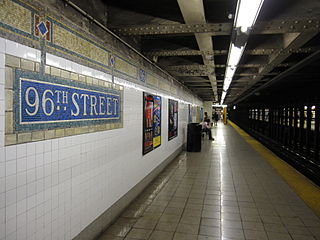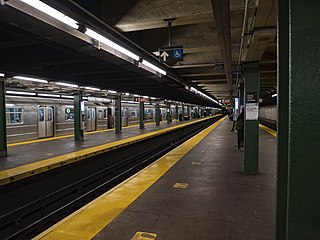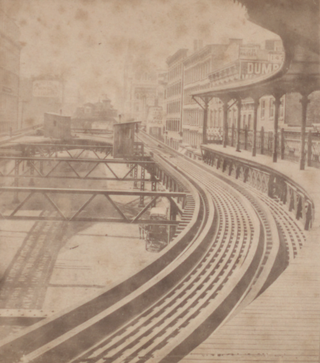
The Interborough Rapid Transit Company (IRT) was the private operator of New York City's original underground subway line that opened in 1904, as well as earlier elevated railways and additional rapid transit lines in New York City. The IRT was purchased by the city in June 1940, along with the younger BMT and IND systems, to form the modern New York City Subway. The former IRT lines are now the A Division or IRT Division of the Subway.

The 77th Street station is a local station on the IRT Lexington Avenue Line of the New York City Subway, located at the intersection of Lexington Avenue and 77th Street on the Upper East Side of Manhattan. It is served by the 6 train at all times, the <6> train during weekdays in the peak direction, and the 4 train during late nights.

The 96th Street station is a local station on the IRT Lexington Avenue Line of the New York City Subway. Located at the intersection of Lexington Avenue and 96th Street in the Carnegie Hill and East Harlem neighborhoods of Manhattan, it is served by the 6 train at all times, the <6> train during weekdays in the peak direction, and the 4 train during late nights.

The 103rd Street station is a local station on the IRT Lexington Avenue Line of the New York City Subway. Located at the intersection of Lexington Avenue and 103rd Street in East Harlem, it is served by the 6 train at all times, the <6> train during weekdays in the peak direction, and the 4 train during late nights.

The 110th Street station is a local station on the IRT Lexington Avenue Line of the New York City Subway. Located in East Harlem at the intersection of 110th Street and Lexington Avenue, it is served by the 6 train at all times, the <6> train during weekdays in the peak direction, and the 4 train during late nights.

The 116th Street station is a local station on the IRT Lexington Avenue Line of the New York City Subway. Located at the intersection of Lexington Avenue and 116th Street in East Harlem, it is served by the 6 train at all times, the <6> train during weekdays in the peak direction, and the 4 train during late nights.

The Hunts Point Avenue station is an express station on the IRT Pelham Line of the New York City Subway, served by the 6 train at all times and the <6> train on weekdays in the peak direction. It is located at Hunts Point Avenue and Southern Boulevard in the Longwood neighborhood in the Bronx.

The 167th Street station is a local station on the IRT Jerome Avenue Line of the New York City Subway. Located at the intersection of 167th Street and River Avenue in the Bronx, it is served by the 4 train at all times. This station was constructed by the Interborough Rapid Transit Company as part of the Dual Contracts and opened in 1917.

The Grand Central–42nd Street station is a major station complex of the New York City Subway. Located in Midtown Manhattan at 42nd Street between Madison and Lexington Avenues, it serves trains on the IRT Lexington Avenue Line, the IRT Flushing Line and the 42nd Street Shuttle. The complex is served by the 4, 6, and 7 trains at all times; the 5 and 42nd Street Shuttle (S) trains at all times except late nights; the <6> train during weekdays in the peak direction; and the <7> train during rush hours and early evenings in the peak direction.
The IRT Lexington Avenue Line is one of the lines of the A Division of the New York City Subway, stretching from Lower Manhattan north to 125th Street in East Harlem. The line is served by the 4, 5, 6, and <6> trains.
The IRT Jerome Avenue Line, also unofficially known as IRT Woodlawn Line and IRT Burnside Avenue Line is an A Division New York City Subway line mostly along Jerome Avenue in the Bronx. Originally an Interborough Rapid Transit Company-operated route, it was built as part of the Dual Contracts expansion and opened in 1917 and 1918. It is both elevated and underground, with 161st Street–Yankee Stadium being the southernmost elevated station. The line has three tracks from south of the Woodlawn station to the 138th Street–Grand Concourse station. The Woodlawn Line also has a connection to the Jerome Yard, where 4 trains are stored, just north of the Bedford Park Boulevard–Lehman College station.

34th Street–Penn Station is an express station on the IRT Broadway–Seventh Avenue Line of the New York City Subway. Located at the intersection of 34th Street and Seventh Avenue, it is served by the 1 and 2 trains at all times, and the 3 train at all times except late nights. Connections are available to the LIRR, NJ Transit and Amtrak at Pennsylvania Station.

The Franklin Street station is a local station on the IRT Broadway–Seventh Avenue Line of the New York City Subway, located at the intersection of Franklin Street, Varick Street, and West Broadway. It is served by the 1 train at all times and by the 2 train during late nights.

The 18th Street station is a local station on the IRT Broadway–Seventh Avenue Line of the New York City Subway. Located at the intersection of 18th Street and Seventh Avenue in Manhattan, it is served by the 1 train at all times and by the 2 train during late nights.

The 23rd Street station is a local station on the IRT Broadway–Seventh Avenue Line of the New York City Subway. Located at 23rd Street and Seventh Avenue in Chelsea, Manhattan, it is served by the 1 train at all times and by the 2 train during late nights. The station was built by the Interborough Rapid Transit Company (IRT) as part of the Dual Contracts with New York City, and opened on July 1, 1918. The station had its platforms extended in the 1960s, and was renovated in the 1990s.

The 28th Street station is a local station on the IRT Broadway–Seventh Avenue Line of the New York City Subway. Located at the intersection of 28th Street and Seventh Avenue in Manhattan, it is served by the 1 train at all times and by the 2 train during late nights.

The Houston Street station is a local station on the IRT Broadway–Seventh Avenue Line of the New York City Subway. Located at West Houston and Varick Streets in Greenwich Village, Manhattan, it is served by the 1 train at all times and by the 2 train during late nights.

The Lexington Avenue/59th Street station is a New York City Subway station complex shared by the IRT Lexington Avenue Line and the BMT Broadway Line. It is located at Lexington Avenue between 59th and 60th Streets, on the border of Midtown and the Upper East Side of Manhattan. The station complex is the fourteenth-busiest in the system, with over 21 million passengers in 2016.

The 42nd Street station was an elevated express station on the demolished IRT Third Avenue Line in Manhattan, New York City. It had two levels with the lower level having three tracks. The main line tracks were served by two side platforms. A side platform connected to the southbound platform was used for shuttle service to Grand Central. The upper level was built as part of the Dual Contracts, and had one track and two side platforms over the two local tracks.























